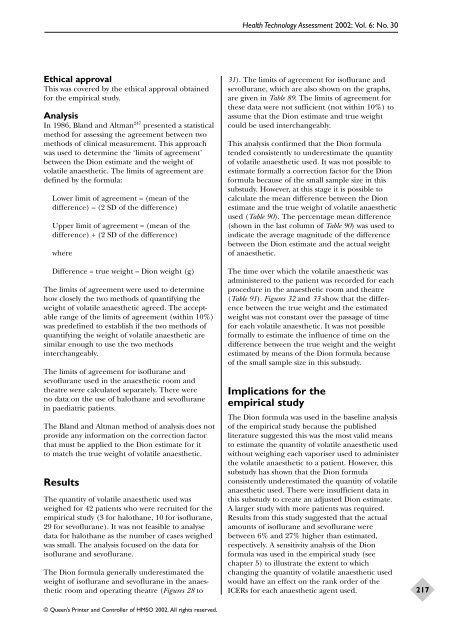Aanesthetic Agents for Day Surgery - NIHR Health Technology ...
Aanesthetic Agents for Day Surgery - NIHR Health Technology ...
Aanesthetic Agents for Day Surgery - NIHR Health Technology ...
Create successful ePaper yourself
Turn your PDF publications into a flip-book with our unique Google optimized e-Paper software.
Ethical approval<br />
This was covered by the ethical approval obtained<br />
<strong>for</strong> the empirical study.<br />
Analysis<br />
In 1986, Bland and Altman 247 presented a statistical<br />
method <strong>for</strong> assessing the agreement between two<br />
methods of clinical measurement. This approach<br />
was used to determine the ‘limits of agreement’<br />
between the Dion estimate and the weight of<br />
volatile anaesthetic. The limits of agreement are<br />
defined by the <strong>for</strong>mula:<br />
Lower limit of agreement = (mean of the<br />
difference) – (2 SD of the difference)<br />
Upper limit of agreement = (mean of the<br />
difference) + (2 SD of the difference)<br />
where<br />
Difference = true weight – Dion weight (g)<br />
The limits of agreement were used to determine<br />
how closely the two methods of quantifying the<br />
weight of volatile anaesthetic agreed. The acceptable<br />
range of the limits of agreement (within 10%)<br />
was predefined to establish if the two methods of<br />
quantifying the weight of volatile anaesthetic are<br />
similar enough to use the two methods<br />
interchangeably.<br />
The limits of agreement <strong>for</strong> isoflurane and<br />
sevoflurane used in the anaesthetic room and<br />
theatre were calculated separately. There were<br />
no data on the use of halothane and sevoflurane<br />
in paediatric patients.<br />
The Bland and Altman method of analysis does not<br />
provide any in<strong>for</strong>mation on the correction factor<br />
that must be applied to the Dion estimate <strong>for</strong> it<br />
to match the true weight of volatile anaesthetic.<br />
Results<br />
The quantity of volatile anaesthetic used was<br />
weighed <strong>for</strong> 42 patients who were recruited <strong>for</strong> the<br />
empirical study (3 <strong>for</strong> halothane, 10 <strong>for</strong> isoflurane,<br />
29 <strong>for</strong> sevoflurane). It was not feasible to analyse<br />
data <strong>for</strong> halothane as the number of cases weighed<br />
was small. The analysis focused on the data <strong>for</strong><br />
isoflurane and sevoflurane.<br />
The Dion <strong>for</strong>mula generally underestimated the<br />
weight of isoflurane and sevoflurane in the anaesthetic<br />
room and operating theatre (Figures 28 to<br />
© Queen’s Printer and Controller of HMSO 2002. All rights reserved.<br />
<strong>Health</strong> <strong>Technology</strong> Assessment 2002; Vol. 6: No. 30<br />
31). The limits of agreement <strong>for</strong> isoflurane and<br />
sevoflurane, which are also shown on the graphs,<br />
are given in Table 89. The limits of agreement <strong>for</strong><br />
these data were not sufficient (not within 10%) to<br />
assume that the Dion estimate and true weight<br />
could be used interchangeably.<br />
This analysis confirmed that the Dion <strong>for</strong>mula<br />
tended consistently to underestimate the quantity<br />
of volatile anaesthetic used. It was not possible to<br />
estimate <strong>for</strong>mally a correction factor <strong>for</strong> the Dion<br />
<strong>for</strong>mula because of the small sample size in this<br />
substudy. However, at this stage it is possible to<br />
calculate the mean difference between the Dion<br />
estimate and the true weight of volatile anaesthetic<br />
used (Table 90). The percentage mean difference<br />
(shown in the last column of Table 90) was used to<br />
indicate the average magnitude of the difference<br />
between the Dion estimate and the actual weight<br />
of anaesthetic.<br />
The time over which the volatile anaesthetic was<br />
administered to the patient was recorded <strong>for</strong> each<br />
procedure in the anaesthetic room and theatre<br />
(Table 91). Figures 32 and 33 show that the difference<br />
between the true weight and the estimated<br />
weight was not constant over the passage of time<br />
<strong>for</strong> each volatile anaesthetic. It was not possible<br />
<strong>for</strong>mally to estimate the influence of time on the<br />
difference between the true weight and the weight<br />
estimated by means of the Dion <strong>for</strong>mula because<br />
of the small sample size in this substudy.<br />
Implications <strong>for</strong> the<br />
empirical study<br />
The Dion <strong>for</strong>mula was used in the baseline analysis<br />
of the empirical study because the published<br />
literature suggested this was the most valid means<br />
to estimate the quantity of volatile anaesthetic used<br />
without weighing each vaporiser used to administer<br />
the volatile anaesthetic to a patient. However, this<br />
substudy has shown that the Dion <strong>for</strong>mula<br />
consistently underestimated the quantity of volatile<br />
anaesthetic used. There were insufficient data in<br />
this substudy to create an adjusted Dion estimate.<br />
A larger study with more patients was required.<br />
Results from this study suggested that the actual<br />
amounts of isoflurane and sevoflurane were<br />
between 6% and 27% higher than estimated,<br />
respectively. A sensitivity analysis of the Dion<br />
<strong>for</strong>mula was used in the empirical study (see<br />
chapter 5) to illustrate the extent to which<br />
changing the quantity of volatile anaesthetic used<br />
would have an effect on the rank order of the<br />
ICERs <strong>for</strong> each anaesthetic agent used.<br />
217
















